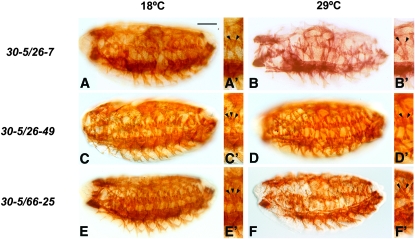Figure 8.—
Skeletal muscle phenotypes arising from heteroallelic crosses of new Mef2 alleles with the 30-5 allele. Stage 16 embryos were stained with anti-tropomyosin to visualize skeletal muscle patterning and differentiation. Embryos were raised at the permissive temperature (18°) and the restrictive temperature (29°) to compare phenotypes at the two temperatures. All embryos are sagittal views with anterior to the left. Arrows indicate skeletal muscles. Small figure panels show magnified images of single segments, highlighting the LT 1–3 muscles (arrowheads). (A and B) The 26-7/30-5 embryos were severely mutant at both temperatures. (A′ and B′) At both temperatures many segments contained only two LT 1–3 muscles (arrowheads), as opposed to three LT normally observed in wild type. (C and D) The 26-49/30-5 phenotype was temperature sensitive: at 18° the phenotype was closer to wild type (C), with predominantly three LT muscles per segment (C′). At 29° the phenotype was more severe (D), with some segments having only two LT muscles (D′). (E and F) The 66-25/30-5 crosses were also temperature sensitive, with similar phenotypes to those of the 26-49/30-5 crosses. At 18° the phenotype of the mutant (E) was closer to wild type, with three LT 1–3 muscles per segment (E′). At 29° the phenotype was more severe (F), with some segments having only two LT muscles (F′). Bar, 100 μm for main panels; 150 μm for insets.

